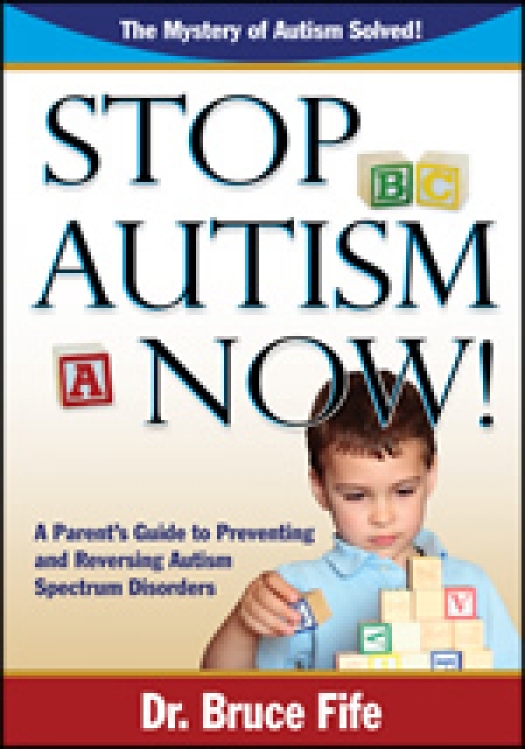stopautismnowbkcvr.jpg

Stop Autism Now! A Parent’s Guide to Preventing and Reversing Autism Spectrum Disorders by Bruce Fife, ND
Autism is a brain disorder characterized by impaired communication, poor social interaction, and abnormal repetitive behaviors. The most obvious characteristic is difficulty with both verbal and nonverbal communication. About 40 percent of autistic children never learn to speak. Many seem to have no understanding of facial expressions or body language such as a smile or a wave. Those who can speak may do so with difficulty. Others may not learn to speak until later in childhood. Between 25-40 percent develop normally for the first 12 to 18 months of life and then rapidly lose their language skills.
Currently over 1 million people have autism. This number is rapidly growing. Over the past several years autism has increased to epidemic proportions. Thirty years ago it affected only 1 in 2,500; today 1 out of every 88 children in the United States has autism.
To most people, autism is a mystery. Doctors have no clue what causes it or why it is increasing so rapidly and have no idea how to prevent or successfully treat it. The only medically recognized form of treatment is an attempt to teach affected children how to manage the disorder and live with it. Antidepressants, antipsychotics, and stimulants are often prescribed to help them cope with their symptoms. No possibility of a cure is offered, as the condition is considered hopeless.
A number of theories have been proposed as to its cause including genetics, vaccinations, and allergies, yet these conditions cannot explain all cases of this terrible disorder. A new book titled Stop Autism Now! A Parent’s Guide to Preventing and Reversing Autism Spectrum Disorders finally solves the mystery and reveals the underlying cause of autism – a chronic hyperactive immune response in the brain – and explains how to correct it.1
The most rapid period of brain growth and development occurs during the last three months of pregnancy and the first two years after birth. During this time the brain more than quadruples in size. This is the most critical stage of brain development. It is during this time that the brain is most susceptible to the influences that can lead to autism.
Our immune system is our primary defense against harmful agents such as infections and toxins. However, due to the blood-brain barrier, the central nervous system is generally inaccessible to the white blood cells and antibodies that protect us from harm. Therefore, the brain has its own immune system, separate from the rest of the body. Specialized brain cells called microglia act as the brain’s primary defense system.
Normally, microglia exist in a resting state. When activated by bacteria, virus, or toxins they spring into action, quickly proliferating, enlarging, mobilizing, and going on the attack, engulfing these foreign substances and removing damaged cells. Essentially, they take on the duties and character of white blood cells. In the process, they release chemical signals that increase blood flow into the brain, stimulate inflammation, and rally various substances to their aid. After the crisis is over, the microglia gradually return to their normal docile existence.
Ordinarily, this process protects the brain while stimulating cleanup and repair. However, during microglia activation some collateral damage is sustained. It’s somewhat like firefighters putting out a fire. As they flood the burning building with water and break out windows for air circulation, they cause some damage themselves. However, this damage is necessary in order to save the building from total destruction and to prevent the fire from spreading. Once the fire is out, cleanup and repair restores the building to its former use.
When microglia are activated, they initiate the release of a variety of substances to aid in the brain’s defense. While beneficial in the short run, some of these substances, such as proinflammatory cytokines and chemokines, nitric oxide, excitotoxins, proteases, and free radicals, are potentially harmful to brain tissues.
Frequent exposure to harmful agents can keep the microglia continually activated, stoking the flames of inflammation and promoting tissue damage. Chronic inflammation disrupts the brain’s ability to absorb glucose, its primary source of fuel. Consequently, brain cells are in a continuous state of starvation. In a small child, this can seriously interfere with normal brain function and growth and even cause developmental regression.
In 2003 neurosurgeon Russell Blaylock, MD, proposed the idea that autism was caused by the over-activation of the brain’s immune system. Repeated immune stimulation from vaccinations, infections, and environmental toxins (including mercury and aluminum) could result in severe disruption of proper brain development and function leading to autism.2
Two years after the publication of Blaylock’s paper, researchers at Johns Hopkins University published a study that supported his hypothesis. The researchers examined brain tissues from 18 people with autism, aged 5 to 44 years, who had died from accidents or injuries. They also measured levels of inflammatory proteins in the cerebrospinal fluid (the fluid that surrounds the brain and spinal cord) in six living autistic patients, ages 5 to 12 years. In each case, they found extensive activation of the microglia and widespread elevated inflammation. The evidence indicated that brain immune activation had persisted for years.3 The Johns Hopkins team concluded that overstimulation of the brain’s immune system plays a key role in the pathogenesis of autism. They suggested the use of therapies that would modify immune responses in the brain as a way to treat autistic patients. These findings have now been confirmed by a number of other researchers.4-8
Microglia over activation can be caused by a number of factors including exposure to environmental toxins, heavy metals, infections, head trauma, certain drugs (including vaccinations), and food allergies. Each one of these can trigger microglia activation. Overexposure to any one or repeated exposure to a combination of these factors can lead to micoglia over activation and a disruption in normal glucose metabolism. Exposure can occur before or after birth or both, so a mother’s health during pregnancy is important too.
While conventional medicine offers no effective treatment, autism is not a hopeless condition. It can be prevented and successfully treated without the use of drugs. As the researchers at Johns Hopkins University suggested, the key to fighting autism is to regulate microglia hyperactivity. This can be accomplished using ketone therapy.
Ketones are produced specifically by the body to feed the brain. The brain can use either glucose or ketones to satisfy its energy needs. Ordinarily, the brain gets most of its energy from glucose. Ketones are produced only when blood glucose levels become low. When glucose levels fall, the body starts mobilizing stored fat to produce ketones in order to maintain adequate energy levels.
Richard Veech, MD, a long time ketone researcher and senior scientist with the US National Institutes of Health describes ketones as “superfuel for the brain.” Ketones are a more potent and efficient fuel than glucose. When ketones are available it is like putting high performance gasoline into the tank of your car. You get better gas mileage and higher performance with less wear and tear on the engine and less pollution.
Ketones not only supply a superior source of energy to the brain but trigger the activation of specialized proteins called brain derived neurotrophic factors (BDNFs) that function in brain cell maintenance, repair, and protection.9 Ketones can have an incredible healing effect on the brain. If blood ketone levels are raised high enough they can fuel a heightened level of healing and repair, calm micoglia over activation, relieve oxidative stress, ease chronic inflammation, and stimulate the growth of healthy new brain cells. As a result, normal brain function can be restored.
Ketone levels in the body vary depending on the amount of glucose is in the blood. This is determined by diet. Glucose comes primarily from the carbohydrates in our food. Reducing the consumption of carbohydrate prompts the production of ketones. By replacing carbohydrate in the diet with fat (which is needed in order to produce ketones), blood ketone levels can increase to therapeutic levels. This is the basis for ketogenic diets.
The classic ketogenic diet is very low in carbohydrate (2 percent of daily calorie consumption) and high in fat (90 percent of calories). Ketogenic diets were developed 90 years ago specifically to treat epilepsy and are still used today for this purpose. Recently, they have shown to be just as useful in treating other neurological disorders such as Alzheimer’s, Parkinson’s, narcolepsy (a sleep disorder characterized by sudden, uncontrollable urges to sleep), depression, and migraine headaches, as well as autism.10-14
Preparing meals that consist of 90 percent fat and only 2 percent carbohydrate is very difficult and often unappealing. The purpose of the ketogenic diet is to increase blood levels of ketones to therapeutic levels. Fortunately, there is another way to accomplish this which allows much more flexibility in the diet. This can be achieved by replacing most of the fats in the diet with a source of fat consisting of medium chain triglycerides (MCTs). When MCTs are consumed they are automatically converted into ketones by the liver. This transformation occurs regardless of blood glucose levels. Therefore, therapeutic levels of ketones can be obtained simply by adding an adequate source of MCTs into an otherwise ordinary diet.
There are very few dietary sources of MCTs. The richest dietary source by far comes from coconut oil, which is composed predominately of MCTs. Eating coconut oil can raise blood ketones to levels that can have a pronounced effect on brain growth and development. If the MCTs are combined with a typical low-carb diet the effects can even be enhanced.
Thanks to coconut oil, a diagnosis of autism is no longer a life sentence. A cure is possible. This new approach is proving to be highly effective at stopping the progression of the disease, significantly improving symptoms, and in many cases even bringing about complete recovery.
References
1. Fife, B. Stop Autism Now! A Parent’s Guide to Preventing and Reversing Autism Spectrum Disorders. Piccadilly Books, Ltd.:Colorado Springs, CO, 2012.
2. Blaylock, R.L. Central role of excitotoxicity in autism. JANA 2003; 6(1):10-22.
3. Vargas, D.L., et al. Neuroglial activation and neuroinflammation in the brain of patients with autism. Ann Neurol 2005; 57:67-81.
4. Zimmerman, A.W., et al. Cerebrospinal fluid and serum markers of inflammation in autism. Pediatr Neurol 2005; 33:195-201.
5. Chez, M.G., et al. Elevation of tumor necrosis factor-alpha in cerebrospinal fluid of autistic children. Pediatr Neurol 2007; 36:361-365.
6. Li, X., et al. Elevated immune response in the brain of autistic patients. J Neuroimmunol 2009; 207:111-116.
7. Sajdel-Sulkowska, E.M., et al. Increase in cerebellar neurotropin-3 and oxidative stress markers in autism. Cerebellum 2009; 8:366-372.
8. Molloy, C.A., et al. Elevated cytokine levels in children with autism spectrum disorder. J Neuroimmunol 2006; 172:198-205.
9. Maalouf, M., et al. The neuroprotective properties of calorie restriction, the ketogenic diet, and ketone bodies. Brain Res Rev 2009; 59:293-315.
10. Reger, M.A., et al. Effects of beta-hydroxybutyrate on cognition in memory-impaired adults. Neurobiol Aging 2004; 25:311-314.
11. VanItallie, T.B., et al. Treatment of Parkinson disease with diet-induced hyperketonemia: a feasibility study. Neurology 2005; 64:728-730.
12. Husain, A.M., et al. Diet therapy for narcolepsy. Nuerology 2004;62:2300-2302.
13. Strahlman, R.S. Can ketosis help migraine sufferers? A case report. Headache 2006; 46:182.
14. Evangeliou, A., et al. Application of a ketogenic diet in children with autistic behavior: pilot study. J Child Neurol 2003; 18:113-118.


